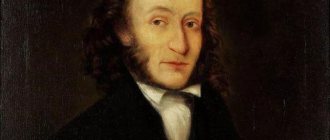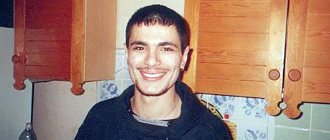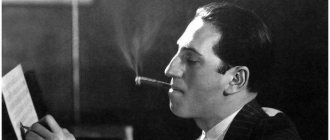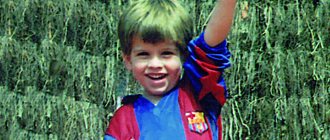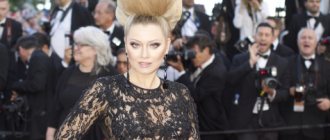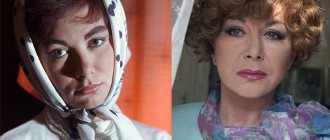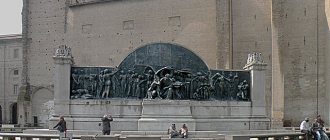Biography of Rudolf Nureyev
Rudolf Khametovich Nuriev is a brilliant ballet dancer who made an invaluable contribution to world culture. His virtuosic performances - temperament, special plasticity, eroticism, expression, dynamics, frantic jump - drove fans crazy and became landmark events in the history of art.
In the photo: Rudolf Nureyev
The student of the Leningrad ballet was a “defector”, a “traitor to the motherland”, the owner of a complex character, a multimillionaire, the owner of luxury apartments, islands, antiques, the object of love of thousands of women, who preferred men in bed.
In 1964, at the Vienna Opera after Swan Lake, he was called to the stage for an encore 89 times. The record has not been broken to this day.
Login to the site
Friends, for those who are not yet familiar with the life story of Rudolf Nureyev, this information will be very interesting. The biography of Rudolf Nureyev causes a lot of controversy and different opinions, but leaves no one indifferent.
Dossier: Rudolf Khametovich Nureyev (Nureev). Date of birth: March 17, 1938. Date of death: January 6, 1993 (age 54). Occupation: Soviet, English and French ballet dancer and choreographer.
In 1983-1989, Rudolf Nureyev was the artistic director of the Paris Grand Opera ballet. In 1991 he made his debut as a conductor in Vienna.
Citizenship: USSR, Austria. Awards: (France) Commander of the Order of Arts and Letters, Knight of the Legion of Honor. Height 1.73 m
Biography of Rudolf Nureyev - the path to success
Childhood and youth
Unusual and unlike others, Rudolf Nureyev was born also unusually - he was born on a train, somewhere near Irkutsk. Of four children, he was the only son.
His family was of Tatar origin, from the Soviet Bashkir Republic. His father was a military man. Soon after Rudolf's birth, he was assigned to Moscow.
Nureyev family
In 1941, the war began. Rudik and his mother and sisters moved from Moscow to Ufa. They lived in a wooden house with other families.
Living conditions were disgusting, the toilet was on the street. Everyone lived in extreme poverty, but the Nureyev family was the poorest of all.
History of the scar: in early childhood, Rudik was bitten by a starving dog. This happened at the moment when he brought a piece of bread to his mouth.
When Rudolph entered school, everyone bullied him because he wore his sister's coat and had no shoes.
(Looking ahead, it should be noted that Rudolf Nureyev would later be one of the richest people in the world: a huge apartment in Paris, a huge apartment in New York, a personal island, unique collections of porcelain, sculptures and paintings).
On New Year's Eve 1945, Rudolf's mother managed to get all the children to see the ballet "The Song of the Cranes" with one ticket, which took place at the Ufa theater. This event changed Rudik's fate.
From that moment on, Nuriev decided to become a dancer. He began attending a school folk dance club. Then he studied at the House of Culture with the St. Petersburg ballerina Anna Udaltsova, who was in exile. Convinced of the boy’s abilities, he was given the idea of continuing his studies at the prestigious Leningrad Ballet School.
At the age of fifteen, Nuriev made his debut in the corps de ballet on the stage of the Bashkir State Opera and Ballet Theater, and in 1954 he was accepted into the theater troupe.
Further studies in Leningrad seemed impossible, especially since the father forbade his son to go to dance classes under the pretext that this would interfere with schoolwork. But Rudolph was stubborn!
In 1955, despite the large age gap, he was admitted to the Leningrad Choreographic School. He studied in the class of Alexander Pushkin, a ballet dancer and outstanding teacher.
Rudolf did not have a good relationship with other students. They teased him and called him a hillbilly. Rudolf could not get along at the boarding school and had to live with his teacher.
Nuriev and Dudinskaya
After graduating from college in 1958, thanks to the prima ballerina Natalia Dudinskaya, he remained in Leningrad and was accepted into the Opera and Ballet Theater named after S. M. Kirov (since 1992 - the Mariinsky Theater).
"Laurencia." Rudolf Nureyev and Natalia Dudinskaya
He made his stage debut as Dudinskaya's partner in the ballet Laurencia, performing the role of Frondoso. It was a stunning success! She was 49 years old, and Nuriev was 19!
"Defector"
On June 16, 1961, while on tour in Paris, by decision of the KGB “for violating the regime of being abroad,” Nuriev was removed from further tours of the Kirov Theater troupe in London. But he refused to return to the USSR and asked for political asylum.
Rudolf Nureyev became a “defector” - the first among artists. In connection with this, he was convicted in the USSR of treason and sentenced in absentia to 7 years in prison.
In Paris, Nureyev was immediately accepted into the touring troupe of the Marquis de Cuevas Ballet. But France refused to give him political refugee status and Nureyev went to Denmark, where he danced with the Royal Copenhagen Ballet, then moved to London.
Eric Brun and Rudolf Nureyev
In 1962, Nuriev met the famous Danish dancer Erik Brun, who had a great influence on the development of the dancer’s choreography and style. Brun is a huge Dane of unearthly beauty, a world famous dancer, considered one of the most outstanding dancers of the 20th century.
Eric Brun
It is difficult to say who was Nureyev’s first man lover, but the fact that Erik Brun became his first and greatest love of his life is undeniable. Moreover, Nuriev first fell in love with his dance, and then with him.
Eric was Nureyev's ideal. He was 10 years older than him, tall and handsome, like a god. From birth, he possessed those qualities that Nureyev was completely deprived of: calm, restraint, tact. And most importantly, he could do what Nureyev could not. Rudolph was the complete opposite of Eric. It is no secret that Nureyev had an obnoxious character; he could be quite rude and harsh.
Rudolph and Eric
Their stormy love affair, which lasted a quarter of a century, finally collapsed when Rudolph learned that in Toronto (where Eric then directed the National Ballet of Canada) Eric began an affair with one of his students, who eventually gave birth to a daughter from him.
But although everything was over with the love relationship between them, the spiritual connection lasted until the end of their lives, surviving all the betrayals, conflicts, and separations.
“My Danish friend Erik Brun helped me more than I can express,” Nureyev said in an interview. “I need him more than anyone.”
Brun died of lung cancer in 1986. He smoked a lot! Rudolf took Eric's death seriously and was never able to recover from this blow.
Margot Fonteyn and Rudolf Nureyev
In 1962, Nuriev signed a contract with the Royal London Ballet, which was unprecedented: people without British citizenship were not accepted there. But an exception was made for Nureyev, and he became a partner with the brilliant English ballerina Margot Fonteyn.
Margot Fonteyn and Rudolf Nureyev
In England, Fontaine was the only and brightest “star” (the wife of Panamanian lawyer and diplomat Tito de Arias). When she met Nureyev, she was 42 years old (he was 24) and was about to leave the stage. It was Nuriev who breathed incredible sensuality into her dance. They were considered the most harmonious ballet duet of their time.
Of course, it was a platonic and, first of all, creative union, but when you look at recordings of their dances today, you involuntarily come to the conclusion that they were connected by a very deep feeling.
For almost 10 years, until Fonteyn left the stage, Rudolph continued to be her constant partner.
Five years after Eric's death, Rudolph said goodbye to the lady of his heart, Margot Fonteyn. She died on February 21, 1991, twenty-nine years to the day since she and Rudolph first danced in Giselle. He was her partner in performances almost 700 times! According to her wishes, Margot was buried in the same grave with her husband, whom she outlived by two years.
Rudolf Nureyev and his men
Rudolf Nureyev was homosexual, but in his youth he also had heterosexual relationships.
Rudolf Nureyev met with many partners, among whom they name (remember that no one held a candle here) Freddie Mercury, Mig Jagger, Elton John and Jean Marais, but Nureyev loved only one – Eric Brun. For Nureyev, he was more than a loved one. After Brun's death, Nureyev no longer had strong feelings for anyone.
Many will condemn Nureyev. But this is his personal life. As Thomas Noirwit (Conchita) said: “Only the individual is important, everyone should have the right to live as he sees fit, as long as it does not harm anyone.”
Date with mother
In 1987, he was able to obtain permission to enter the USSR to say goodbye to his dying mother - the visa was given for 48 hours, and the artist was not given the opportunity to contact everyone he knew in his youth.
Cause of death of Rudolf Nureyev
In 1983, HIV was discovered in the dancer’s blood. Diagnostics have shown the presence of the virus in the blood for several years. At that time, very little was known about the disease: the dancer did not begin treatment immediately and took experimental medications. The disease progressed. Nureyev died from complications of AIDS on January 6, 1993, near Paris.
Rudolf Nureyev's grave
According to his wishes, he was buried in the Russian cemetery of Sainte-Genevieve-des-Bois near Paris. His grave is covered with a colorful mosaic oriental carpet.
Rudolf Nureyev's grave
Quotes from Rudolf Nureyev
- “I want to be able to work everywhere - in New York, Paris, London, Tokyo and, of course, in what I consider the most beautiful of theaters - the blue and silver Kirovsky in Leningrad. I am twenty four years old. I don’t want anyone to decide my future for me, to determine in which direction I “should” develop. I'll try to get to this point on my own. This is what I understand by the word “freedom”.
- “I dance for my own pleasure. If you're trying to please everyone, it's not original."
- “Every step must bear the imprint of its own blood.”
Secret of success
The dramatic circumstances of his arrival in the West propelled Nureyev to first place, but he held on thanks to his strong personality.
Performing tirelessly, every evening, for months, for years, all over the world, in the widest repertoire, he touched more audiences than any other dancer. In 1975, the number of performances reached three hundred! He completely changed the passive role of the dancer in classical ballet.
Once in an interview, Rudolf Nureyev was asked what was the secret of the success of his work abroad. He replied: “I slept little and worked a lot.” And this determined his whole life. Source publications
Childhood and youth
The parents of the future dance genius came from poor peasants. Rudolf has Tatar and Bashkir roots in his blood. Mother, Farida, was from the Kazan province, father, Khamet, from Ufa. He managed to graduate from a madrasah (Muslim church school), joined the party, became a political instructor and, due to his occupation, often moved from one military unit to another.
Rudolf Nureyev in childhood with his mother
In 1938, Khamet served in Manchuria and summoned his pregnant wife and three daughters to his place. The long-awaited son was born on March 17, on the way to his new place of residence, when the train passed Lake Baikal. A year and a half later, in connection with the new appointment of the head of the family, the Nureyevs (the dancer’s surname was originally written with an E) moved to Moscow.
With the beginning of the war, the father went to the front, and the children and mother were evacuated in the suburbs of Ufa. Then Rudik had to learn what hunger, cold and poverty were. They huddled together with two other families in a twelve-meter room.
Rudolph grew up as a serious, sensitive child, loved to listen to music on the radio with his sisters, sit on a hill near the railroad and watch the trains rushing by. In the summer, to help his mother, he sold fresh cold drinking water from a can and old newspapers.
Little Rudolph with his older sisters
At the age of 5, a significant event occurred in the boy’s life that predetermined his fate. His mother took him and his sisters to the Ufa Opera House to see the ballet “Crane Song”. What he saw was a real shock for the child. He was delighted with the festive atmosphere, the beautiful crystal chandeliers sparkling in the light of the lamps, the golden curtain, the artists appearing in bright outfits. From that moment on, he had a dream - to dance.
Rudolf began attending classes in a children's folklore ensemble, happily mastering the basics of choreographic art, and participating in concerts in hospitals, nearby villages, and enterprises. All the neighbors and acquaintances vied with each other in praising him and assuring Farida of her son’s talent. But the father, who returned from the front, considered the passion for dance unworthy of a man and wanted his son to become an engineer or doctor. Rudik’s classmates also laughed at him, especially when he came to class wearing his older sisters’ clothes. But contrary to the will of his father and the ridicule of his peers, he continued to study ballet.
When the boy turned 11 years old, his teacher was a former member of the famous Diaghilev troupe, Anna Udaltsova, who drew attention to the abilities and amazing determination of the silent, poorly dressed boy. He not only worked hard at dancing, but also read a lot (Hemingway, Dreiser, Zola), diligently studied French, and played the piano. At the age of 15, he already successfully performed on the stage of the Ufa Opera, and at 17, he went to the city on the Neva to enter the choreographic school and develop his talent. He was accepted, despite his inappropriate age, and was assured that either a bright future or great disappointment awaited him.
Rudolf Nureyev in his youth
Almost immediately, the newly minted student found himself on the verge of expulsion due to a suddenly hostile relationship with his mentor, who offended his creative impulses. Then Nuriev showed his character and decided on a rather daring act - he submitted an application to change his teacher. And they met him halfway - they transferred Alexander Ivanovich Pushkin to the senior class. He worked well with him and subsequently practically lived in his family - it was difficult for the young man to get along in the dorm with his 12-year-old fellow students, who considered him a hillbilly and an over-aged ignoramus. But the experienced teacher appreciated the diligence, musicality and potential of the new pupil.
First ballet
But not everything was so bad during the evacuation years. At the age of five, Rudolf attended ballet for the first time. They staged “The Crane Song”. From that moment on, he was inspired by the idea of dancing, and Farida sent her son to a dance club at the kindergarten. Rudolf eagerly studied and even performed with the rest of the circle members in front of the wounded soldiers.
His father returned from the war when Nureyev was eight years old. Raising his son shocked his father: he was the complete opposite of what some call a “real man.” Not only was Rudolf physically very weak, but he also practiced dancing, which was not at all welcomed among the martinet community. Khamet immediately began “re-education”: he beat his son when he attended a dance club, and described to him all the delights of a worker’s life. When almost all the children from the dance club went to Leningrad to continue their studies, Khamet did not let his son in, citing lack of money.
But his father was never able to turn Rudolf’s heart to the construction projects of Stalin’s five-year plans. Weak physically, Nureyev Jr. was very strong in spirit. Together with his mother, he managed to break his father's stubbornness. Former soloist of the Diaghilev Ballet Anna Udaltsova lived in exile in Ufa. It was she who studied with Rudolf, and she insisted that the capable boy enter the school in Leningrad.
In 1955, a festival of art of Bashkiria was held in Moscow, at which Nureyev’s dance troupe was supposed to perform the same “Crane Song”. Rudolf was lucky: the lead singer suddenly fell ill. In a short time, despite the danger to his health, the young man learned the entire part and conquered the entire audience, despite the injury received during rehearsals. This is how the future “indomitable genius” appeared on the stage - Rudolf Nureyev.
Creative path
In 1958, Rudolf Nureyev graduated from his studies and began working in one of the leading ballet companies in the country - the Theater named after. Kirov (now Mariinsky). He was also invited to the Bolshoi stage, but he refused to leave the Northern capital.
Photo by Rudolf Nureyev
The talented graduate made his debut in the ballet “Laurencia” in the role of the brave Frondoso. Over the next three years, he performed 14 roles in the performances of “La Bayadère”, “Don Quixote”, “Swan Lake”, “Sleeping Beauty”, etc., winning the hearts of numerous fans with his high skill - the soft jump of a night predator, rapid rotation, dramatic acting, the capacity of the dance, the original reading of each part.
In 1959, despite his independent character, Nuriev was taken on tour to Vienna - the Austrians insisted on his arrival as part of the troupe. Two years later, another trip abroad became a turning point in the dancer’s life. The Kirov Ballet then came on tour to Paris, after which it was supposed to go to London.
Rudolph with his long-term partner, ballerina Margot Fonteyn
In the capital of fashion, the dancer, who already at his first performance captivated the Parisian public with his talent and did not tolerate restrictions, violated the Soviet rules of staying abroad. So, in exchange for dutifully spending evenings in a hotel under the supervision of KGB officers, he allowed himself to go out into the city without their escort, communicate with foreigners, and disappear with new acquaintances in a cafe. According to another version, Nuriev was made to understand that the KGB knew about his homosexuality, and in the criminal code of those years there was an article for sodomy. One way or another, in Paris, Rudolph made a leap into freedom that was stunning in its courage and audacity. Rudolf Nureyev. Pas de deux from the ballet “The Nutcracker” Nuriev knew that for his misdeeds he would be returned to the USSR, and at home, along with the deprivation of the title of soloist and foreign business trips, the collapse of his artistic future awaited him, and decided not to return to his homeland. When, under a false pretext - a concert in the Kremlin - Nuriev was called to the airport and tried to be escorted onto a plane flying to the Soviet Union, his French friend, who volunteered to escort the dancer, whispered in his ear: “Do you see two policemen? Go up to them and tell them you want to stay. They are waiting". State security officers tried to prevent the dialogue between Nuriev and the police, but the ballet genius literally jumped at the feet of the law enforcement officers and whispered: “I want to stay.” They did not dare to return the dancer to the plane by force in front of the European public. Contract with death. Rudolf Nureyev | TV channel “History” In the USSR, Rudolf was recognized as a traitor to the motherland and sentenced in absentia to 7 years in prison with confiscation of property. For a long time, the Kremlin put a spoke in the dancer’s wheels, but to no avail. The next time Nuriev visited his homeland was in 1987 to visit his dying mother. Before that, he was not allowed into the USSR. By that time, his father had long been dead from lung cancer, a disease that Rudolf had been afraid of all his life.
THE ESCAPE
Having become popular with viewers, Nureyev also became known to KGB officers as a “dissident.” On tour in Paris in 1961, he behaved provocatively. He made friends from the Parisian bohemia, which was strictly prohibited, and only returned to his hotel room in the morning. The KGB officer assigned to the troupe insisted on Nureyev’s early return to the USSR.
It is unlikely that Rudolf planned to stay in France in advance. At that time he had neither money nor things, and he did not tell anyone about such a desire. After all, he traveled around the city so much without the supervision of the “competent authorities” that he could have contacted the police a hundred times with a corresponding request.
When at the airport they announced to him that he was not flying with the entire troupe to London, but was returning to Moscow, Rudolf realized that he could become “restricted to travel.” According to eyewitnesses, he cried and shouted that he did not believe that he would be able to join the troupe in London in a few days, as he had been promised.
WHERE ARE THE BOYS?
Nureyev dreamed of sex twenty-four hours a day and sought to satisfy his desire in any circumstances: on the street, in a public toilet, bar or gay sauna.
He constantly changed lovers, among whom were such world pop stars as Freddie Mercury, Mick Jagger, Elton John and Jean Marais. Rudolf often shocked those around him by kissing passionately in public and saying that this was an old Russian custom. One day, leaving the Paris Opera building, he saw a crowd of fans and exclaimed displeasedly: “Hey, where are the boys?” The entire troupe of the Kirov Theater had already boarded the plane, and Nureyev was still saying goodbye to his French friend, a dancer from the Paris Theater. Then one of his acquaintances, Clara Saint, went to the police station and declared that “the Russian dancer wants to stay in France.” But according to existing rules, Nureyev himself should have approached them with such a request. The most they could do was to leave their office and stand next to the bar where Nureyev continued to sit.
Clara approached Rudolf and whispered that he should turn to the police with his request. And then Nureyev, breaking through the KGB officers, ran up to the police shouting: “I want to stay in France!” After such a statement, the police took him to their office.
A new life began, which even at first was very successful for Nureyev. He had already gained popularity among the audience, and the headlines of all newspapers were full of information and photographs of his “escape.” Rudolph immediately became a shocking celebrity. He was invited to perform on different stages, the fees became more and more, and the most famous ballerinas wanted to see him as their partner. Nureyev’s appearance and dance always contained incredible magnetism and overflowing sexuality, which captivated the audience and drove them into a frenzy.
Work in the West
The European life of the brilliant dancer in Europe was marked by incredibly fruitful creative activity. At first, he joined the ballet troupe “Ballet Marquis de Cuevas”, then moved to Denmark, where he met the influential dance teacher of the Royal Danish Ballet School, emigrant Vera Volkova, and the famous dancer Erik Brun, who became his close friend and the love of his life.
Rudolf Nureyev and Eric Brun
Then Margot Fonteyn came into his life. The famous English prima ballerina called Nureyev and invited him to dance at her benefit performance in London. Soon the management of the Royal Theater in Covent Garden invited them to dance “Giselle” together. At first, the 42-year-old star was afraid that she would look funny next to the 24-year-old young man, but still agreed. The performance was a huge success - they were called to bows 23 times within 45 minutes. And after Margot handed her partner a rose from her bouquet, and he fell to one knee, showering her hand with kisses, the audience went completely crazy with incredible artistic impressions.
Nureyev with ballerina Margot Fonteyn
In 1962, Rudolph signed a contract with the Royal Theater and until 1970 he soloed with Fontaine at all famous venues in the world, bringing sensual fervor, expression to his performances, striking with dynamics, brightness, sexuality, significance on stage - when he appeared, there were no other dancers saw. His attractiveness seemed simply magical to many. To get to a performance with their participation in the United States, people spent three days on duty at the Metropolitan Opera box office. Rudolf Nureyev - Drunken Tango In 1963, the dancer made his film debut, starring alongside the unforgettable Margot in London in the film "An Evening with the Royal Ballet" as a slave and performing a pas de deux from the ballet "Corsair". A year later, the duet performed triumphantly in Swan Lake at the Vienna Opera. He soon became the leading soloist of this troupe and received Austrian citizenship.
Rudolf Nureyev
In 1966, fans of the dancer could see Nuriev in the film adaptation of the ballet “Young Man and Death”. During the same period, he tried himself as a choreographer - he staged “Tancred” based on Shakespeare’s play. Subsequently, he staged performances at the Royal Swedish Ballet, at the Vienna Opera House, at La Scala, at the American Ballet Theater, and created his own editions of the classic “Giselle,” “Raymonda,” and “Sleeping Beauty.”
In 1972, Nuriev starred in the leading role in the film “I am a Dancer”, also acting as its producer. In 1973, he presented the film-ballet “Don Quixote” to the audience, where he was the performer of the role of Basilio, co-producer and director. This work has been recognized as one of the most successful interpretations of the novel by Miguel de Cervantes.
Rudolf Nureyev in the film "Valentino"
A year later, the project “Nureyev and Friends” appeared. Within its framework, the indomitable miracle dancer performed extremely intensively, annually participating in an incredible number of ballets - up to three hundred. In 1976, the Nureyev Festival started at the London Coliseum Theatre. For a month and a half during the event, he performed every evening with a new program. The same year, he starred in British director Ken Russell's drama Valentino. In 1977, his production premiered “Romeo and Juliet” at the London Coliseum, and two years later “Manfred” premiered at the Paris Palais des Sports.
In 1983, an important event occurred in the life of the world ballet star - he headed the Grand Opera ballet troupe. He remained in this position for six years. It was then that he was diagnosed with HIV. In 1987, he was allowed to come to Ufa for 72 hours to say goodbye to his mother. She died 3 months after their meeting.
Despite the deterioration of his physical condition, the artist continued to work hard. He celebrated his half-century anniversary with a large gala concert in New York. In 1989 he was invited to the Northern capital. During his visit, he performed twice on the stage of his native theater. The audience applauded, but his illness no longer allowed him to shine as before.
Personal life
The personal life of Rudolf Nureyev turned out to be connected with men: the ballet dancer was openly gay. Although some of his friends claim that in his youth he also had affairs with girls. The dancer himself admitted that he could have become a father twice, but his chosen ones terminated their pregnancies for various reasons.
Rudolf Nureyev and Margot Fonteyn / Eric Koch, Wikipedia
Rudolph is also credited with a romantic relationship with his partner, the great ballerina Margot Fonteyn, who was 15 years older. However, the dancers themselves called this connection exclusively spiritual and friendly.
When the ballerina was dying of cancer, Nureyev paid all her medical bills and once said that if he could have made Margot his wife at one time, the lives of both would have been more successful. However, these words rather speak not of an old romance, but of a reluctance to part with life - Rudolf knew that he himself was dying.
Embed from Getty Images Rudolf Nureyev and Eric Brun
At various times, Nureyev was rumored to have had love affairs with such stars as rock musicians Freddie Mercury and Mick Jagger, fashion designer Yves Saint Laurent and singer Elton John. But the main love in Rudolf’s personal life remained the Danish dancer Erik Brun. The men were together for 25 years, until Eric's death in 1986. The relationship between them was not easy, because in terms of temperament the Russian and the Dane turned out to be almost complete opposites.
Personal life of Rudolf Nureyev
Eric Brun became the ideal and love of the legendary dancer. They were close for a quarter of a century, until the Dane died in 1986 at the age of 57 from lung cancer.
Eric Brun and Rudolf Nureyev
The artist was also credited with having affairs with many famous people - with Freddie Mercury, Elton John, Jean Marais, and Yves Saint Laurent. It is unknown how much truth there is in these rumors.
He was the owner of a number of luxury properties in Europe and the USA, and even islands in the Mediterranean Sea. The dancer's fortune was estimated at $80 million. He earned them not by dancing alone - with all his skill, this was impossible. Nuriev had the instincts of an investor, and he invested his fabulous fees in business projects and did not hesitate to cheat with taxes. But even after becoming a dollar millionaire, he continued to dance with his former dedication.
Legendary Rudolf Nureyev
The greatest talent was combined in an unsurpassed dancer with an intolerable character and stinginess. He did not hold back in unprintable language with colleagues, was rude to journalists, and quarreled with administrators. Nureyev, on principle, did not carry cash with him, so his friends paid for it in hot spots.
But at the same time, he was distinguished by incredible hard work and professional discipline: he rehearsed for hours, even after exhausting performances, not paying attention to injuries, he danced through the pain. He lived at a frantic pace: in two days he could visit five countries, leaving him to sleep 4-5 hours a day.
DOCTOR JEKYLL OR MISTER HYDE?
A frequent case for a genius: Nureyev’s personality with his temper, wild antics, lack of contact, and selfishness was combined with an extraordinary contribution to the world ballet art. Nowhere and never could Rudolf easily join the team. It was not a matter of the Soviet education system, but of the deviations of his personality.
He was always a loner; he never managed to connect with the troupe, even on stage. If he had to perform a minor part, he unwittingly diverted the audience's attention to himself, overshadowing the other dancers. This is called the “stage presence effect.”
There are stories about how an enraged Rudolph smashed thermoses with tea on the studio floor and threw ashtrays at the mirrors. He never admitted mistakes and always tried to prove he was right. It was not easy for him to communicate with people. Every insult, real or imagined, deepened his suspicion. Although Rudolph spent a considerable part of his life on airplanes, he was terribly afraid of flying. I always preferred to sit by the window so I could see “exactly where we would crash.”
He played a noble lover on stage, but in life he was arrogant and selfish. Owned an island in the Mediterranean, but did not pay for himself in restaurants. He liked the most beautiful women, but preferred anonymous sex with men. He allocated about two million dollars a year for his health, but died of AIDS.
Apart from his talent, there was little that was attractive about Nureyev. Neither the luxury with which he surrounded himself, nor the society in which he moved, trimmed him and did not save him from his innate peasant rudeness. His pathological stinginess became the talk of the town. He languished over his gold and never carried pocket money, forcing his friends to pay for themselves in stores. However, this is far from an exceptional case when we consider a genius personality.
Rudolph did not recognize himself as a homosexual for a long time, but over time he began to turn to men only for sexual satisfaction. “With women you have to work so hard, and it doesn’t satisfy me very much,” he said. “And with men everything is very fast.”
His desires came first, and he satisfied them under any circumstances and without any remorse. His “sexual appetite” required constant change. Nureyev had many lovers, but he loved none of them except Eric Brun. In the seventies and eighties he had very long relationships with Wallace Potts and with Robert Tracy. They loved him, and Rudolf only allowed them to come to him, treating them very disdainfully. He could not admire them, which means he could not love them.
An unattractive feature of Nureyev was that he was attracted, by his own admission, to “the most dangerous quarters, where terrible individuals and dirty love live.” Having chosen a one-time partner, he quickly made a deal, quickly had sex, and quickly disappeared. Perhaps the fear of being “caught”, acquired while living in the USSR, was taking its toll.
Nureyev’s close friend, choreographer Roland Petit, recalled: “I did not understand how this “god,” who brilliantly dances on stage in the light of day, turns into a demonic character with the onset of darkness.” I can’t help but remember Robert Stevenson’s story “Dr. Jekyll and Mister Hyde.”
Love and sex were not always interrelated concepts for Nureyev. Going to bed with someone did not at all mean having tender feelings for your partner. But he valued friendship – with women and men – very highly.
Death
In the fall of 1984, Nuriev complained to his doctor about feeling unwell.
The tests did not show any abnormalities, but this is understandable - only 3 years have passed since the discovery of AIDS, which at that time was positioned as a “cancer for gays” (for some time it was believed that only homosexuals could get AIDS). However, the doctor suspected something was wrong and sent Rudolph to specialists involved in HIV research. New tests showed a positive result. Moreover, as doctors claimed, Nuriev received HIV back in the late 70s. In recent years, one of the brightest dancers in the world could no longer perform, but found a new type of creativity for himself - conducting, amazing professionals with his dedication to the theater, hard work and unique abilities.
Rudolf Nureyev's grave
In 1992, at the premiere of the ballet La Bayadère, staged by him at the Paris Opera, Nuriev was awarded the country's highest award - the Order of the Legion of Honor. The ceremony became the great artist’s farewell to the stage and to life, which for him was one and the same. In January of the following year he passed away.
Rudolph's Relationships
The talented artist never experienced a lack of attention from the opposite sex; his name often appeared in the biographies of famous dancers. But Nureyev’s personal life was predominantly marked by non-traditional sexual orientation. Already during his career in the Soviet Union, the artist was noticed in homosexual relationships. Attempts to bring the young man to disciplinary liability did not have the desired impact. In Europe, the dancer’s partner was a gay Danish artist, Erik Brun.
The young people did not hide their connection and lived together for 25 years. After Brun's death, other men are present in Nureyev's life.
Memory
A choreographic college in Ufa, an annual festival of ballet art, and one of the streets of the city are named after his outstanding compatriot.
In 2020, a monument to the artist appeared in Kazan. In 2020, the premiere of Ralph Fiennes’ film “Rudolf Nureyev: The White Raven” took place in Russia. The film told the story of the famous “leap into freedom”, and the image of Rudolph on the screens was embodied by his compatriot Oleg Ivenko.
Rudolf Nureyev and Oleg Ivenko (right)
